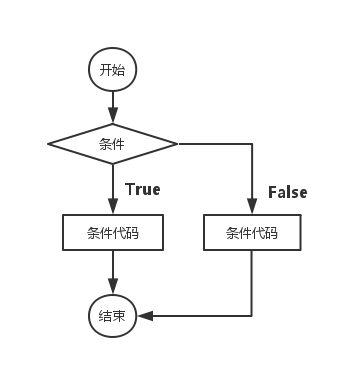Python 条件语句
Python条件语句是通过一条或多条语句的执行结果(True或者False)来决定执行的代码块。
可以通过下图来简单了解条件语句的执行过程:

Python程序语言指定任何非0和非空(null)值为true,0 或者 null为false。
Python 编程中 if 语句用于控制程序的执行,基本形式为:
if 判断条件:
执行语句……
else:
执行语句……
其中"判断条件"成立时(非零),则执行后面的语句,而执行内容可以多行,以缩进来区分表示同一范围。
else 为可选语句,当需要在条件不成立时执行内容则可以执行相关语句,具体例子如下:
#!/usr/bin/env python
#-*- coding: UTF-8 -*-
name = raw_input('Please Input Your Name:')
if 'ruizhong' == name:
print 'Welcome Ruizhong Come Here'
else:
print 'You are Not ruizhong'
执行结果:
[root@ruizhong scripts]# python if_1.py
Please Input Your Name:ruizhong
Welcome Ruizhong Come Here
[root@ruizhong scripts]# python if_1.py
Please Input Your Name:haha
You are Not ruizhong
if 语句的判断条件可以用>(大于)、<(小于)、==(等于)、>=(大于等于)、<=(小于等于)来表示其关系。
当判断条件为多个值是,可以使用以下形式:
if 判断条件1:
执行语句1……
elif 判断条件2:
执行语句2……
elif 判断条件3:
执行语句3……
else:
执行语句4……
实例如下:
#!/usr/bin/env python
#-*- coding: UTF-8 -*-
Num = raw_input('Please Input Your Name:')
if Num == '1' :
print "You input Num is 1"
elif Num == '2' :
print "You input Num is 2"
elif Num == '3' :
print "You input Num is 3"
else:
print "You input Num is not in list (1、2、3)"
执行结果:
[root@ruizhong scripts]# python if_2.py
Please Input Your Name:1
You input Num is 1
[root@ruizhong scripts]# python if_2.py
Please Input Your Name:2
You input Num is 2
[root@ruizhong scripts]# python if_2.py
Please Input Your Name:3
You input Num is 3
[root@ruizhong scripts]# python if_2.py
Please Input Your Name:4
You input Num is not in list (1、2、3)
如果判断需要多个条件需同时判断时,可以使用 or (或),表示两个条件有一个成立时判断条件成功;使用 and (与)时,表示只有两个条件同时成立的情况下,判断条件才成功。
#!/usr/bin/env python
#-*- coding: UTF-8 -*-
Num = input("Please input a num:")
if Num >= 0 and Num <=10:
print "True"
else:
print "False"
执行结果:
[root@ruizhong scripts]# python if_3.py
Please input a num:5
True
[root@ruizhong scripts]# python if_3.py
Please input a num:20
False
当if有多个条件时可使用括号来区分判断的先后顺序,括号中的判断优先执行,此外 and 和 or 的优先级低于>(大于)、<(小于)等判断符号,即大于和小于在没有括号的情况下会比与或要优先判断。
#!/usr/bin/env python
#-*- coding: UTF-8 -*-
Num = input("Please input a num:")
if (Num >= 0 and Num <= 5) or (Num >= 10 and Num <= 20):
print "True"
else:
print "False"
执行结果:
[root@ruizhong scripts]# python if_4.py
Please input a num:3
True
[root@ruizhong scripts]# python if_4.py
Please input a num:12
True
[root@ruizhong scripts]# python if_4.py
Please input a num:40
False
[root@ruizhong scripts]# python if_4.py
Please input a num:6
False